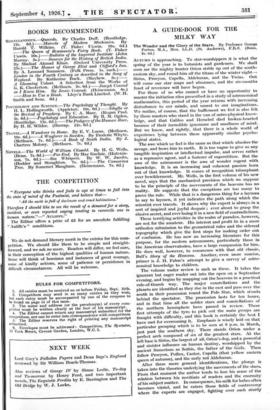A QUIDE-BOOK FOR THE MILKY WAY
AUTUMN is approaching. To star-worshippers it is what the spring of the year is to botanists and gardeners. We shall soon see the mighty hunter Orion stride up out of the south- eastern sky, and round him all the titans of the winter night- Sirius, Procyon, Capella, Aldebaran, and the Twins. Out will come our star maps and almanacs, and the six-months feast of reverence will have begun.
For those of us who cannot or have no opportunity to master the initiation rites prescribed in a study of astronomical mathematics, this period of the year returns with increasing disturbance to our minds, and unrest to our imaginations. We realize, of course, that the bafflement we feel is also felt by those masters who stand in the van of astro-physical know- ledge, and that Galileo and Herschel died broken-hearted because of their incredible ignorance and smallness of mind. But we know, and rightly, that there is a whole world of experience lying between these apparently similar psycho- logical states.
The awe which we feel is the same as that which abashes the savage, and bows him to earth. It is too vague to give us any tangible inspiration or intellectual impulse, and serves rather as a repressive agent, and a fosterer of superstition. But the awe of the astronomer is the awe of wonder cogent with knowledge. It is an increasing and coherent passion born out of that knowledge. It comes of recognition triumphant over bewilderment. Mr. Wells, in the first volume of his new novel, - says that the mechanical precision which we suppose to be the principle of the movements of the heavens has no reality. He suggests that the exceptions arc too many to prove the rule. While that is a dangerous thing for a layman to say to laymen, it yet indicates the path along which the scientist ever travels. It shows why the expert is always in a sort of inspired and joyful despair ; ever about to grasp the elusive secret, and ever losing it in a new field of contradictions.
These terrifying activities in the realm of paradox, however, are not for the amateur. His interest and profit lie in a more orthodox submission to the geometrical rules and the sidereal topography which give the first steps for making order out of confusion. He has now an increasing literature for this purpose, for the modern astronomers, particularly those in the American observatories, have a large compassion for him. He does well, however, to commence with that old classic, Ball's Story of the Heavens. Another, even more concise, primer is J. H. Fabre's attempt to give a survey of astro- nomical knowledge to children.
The volume under review is such as these. It takes the ignorant but eager reader out into the open on a September evening, and begins by mapping out the heavens in a practical rule-of-thumb way. The major constellations and the planets are identified as they rise in the east and pass over the south in their procession round the Pole Star, which stands behind the spectator. The procession lasts for ten hours, and in that time all the nobler stars and constellations of the northern hemisphere have passed in review. These first attempts of the tyro to pick out the main groups are fraught with difficulty, and this book is certainty the best I have met for overcoming it. Emphasis is wisely laid on that particular grouping which is to be seen at 9 p.m. in March, just past the southern sky. There stands Orion under a perfect arch composed of six of the greatest stars. At the left base is Sirius, the largest of all, Orion's dog, and a powerful and sinister influence on human destiny, worshipped by the ancient Sumerians as Sothis, the father of the Gods. Then follow Procyon, Pollux, Castor, Capella (that yellow eastern queen of autumn), and the surly red Aldebaran. After these more general identifications, the plunge is taken into the theories underlying the movements of the stars. From that moment the author tends to lose his sense of the relation between his novitiate of readers and the enormity of his subject matter. In consequence, his milk for babes often becomes vitriol, and he enters those fields of controversy where the experts are engaged, fighting over such sturdy
problems as the origin of solar energy, the generation of spiral nebulae, or the common constitution of stars. He does not let himself go thus far, fortunately, without conscientiously touching on the more stable theories and the facts on which they are built.
While much attention is given to the more spectacular incidents of the astral year, we feel that the reader would better profit had he been more emphatically directed to the Simple physical miracles. For instance, he should at the very beginning learn why it is that he sees the procession of the stars at all. Were it not for the fact that the solar day is four minutes longer than the astral day—due to the movement of the Earth in her orbit round the Sun—we should be sur- rounded by a comparatively fixed empyrean, only one constant hemisphere of which we should ever see. Such a little fact as that, amid all the terrors and splendours of space, tornadoes in the sun, comets, and other excitements of the heavens, is like the still small voice that came to the prophet.
RICHARD CHURCH.



































 Previous page
Previous page